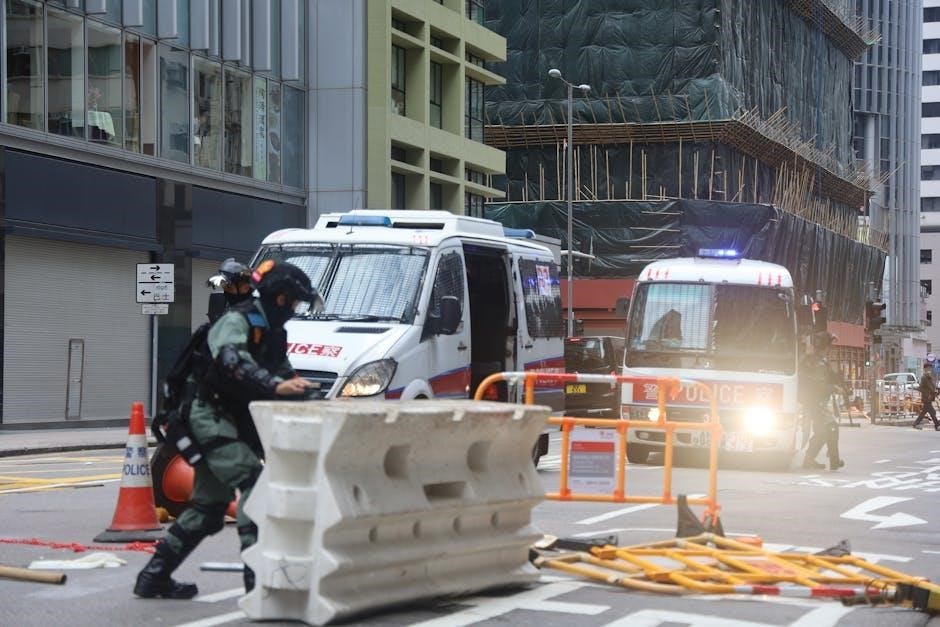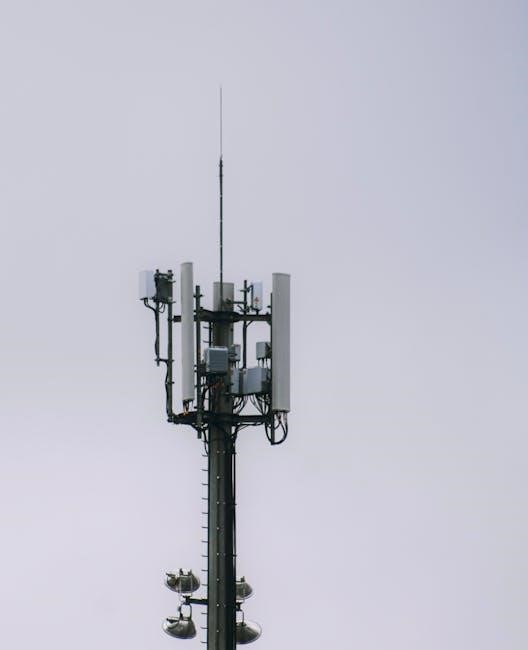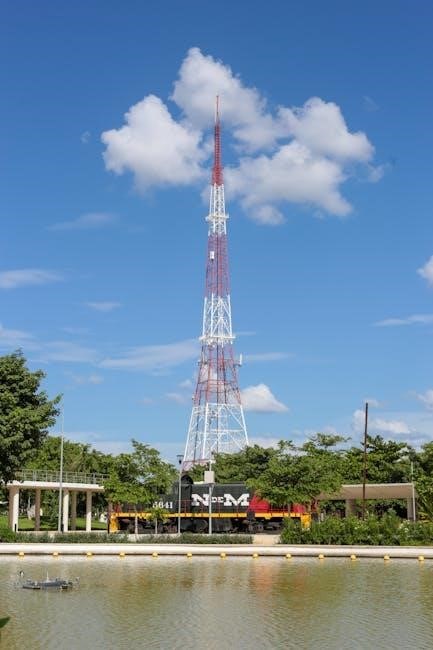
Signal Operating Instructions (SOI) are standardized procedures for secure and efficient communication, ensuring clarity and precision in both military and civilian operations worldwide.
1.1 Definition and Purpose of SOI
Signal Operating Instructions (SOI) are standardized protocols outlining procedures for secure and efficient communication. They define methods for transmitting and receiving signals, ensuring clarity and precision in operations. The primary purpose of SOI is to establish consistent communication practices, reducing errors and enhancing reliability. SOI is crucial in military and civilian contexts, where clear and timely information exchange is critical. By standardizing signals, SOI ensures that all parties understand and interpret messages accurately, maintaining operational integrity and security. These instructions are essential for coordinating actions, managing resources, and responding to emergencies effectively.
1.2 Historical Context and Development
Signal Operating Instructions (SOI) trace their origins to early military communication systems, evolving from manual signaling to advanced digital protocols. Initially developed during World War I and World War II, SOI became critical for coordinating troop movements and battlefield strategies. The U.S. military formalized these procedures in the mid-20th century, integrating radio and encryption technologies. Over time, SOI expanded to include civilian applications, ensuring secure communication in emergencies and public services. The rise of digital communication in the Cold War era further refined SOI, incorporating automated systems and encryption. Today, SOI remains a cornerstone of modern communication, adapting to technological advancements like AI and quantum computing.
1.3 Importance in Military and Civilian Applications
Signal Operating Instructions (SOI) are vital for ensuring secure and efficient communication in both military and civilian contexts. In military operations, SOI enables coordinated strategies, reduces errors, and maintains operational security through standardized protocols. For civilians, SOI supports emergency response systems, law enforcement, and disaster recovery efforts, ensuring timely and accurate information exchange. The use of encryption and authentication in SOI prevents unauthorized access, safeguarding sensitive data. This dual applicability underscores the versatility and critical role of SOI in maintaining order and security across diverse scenarios, making it indispensable in modern communication systems.

Key Components of Signal Operating Instructions
Signal Operating Instructions (SOI) encompass critical elements like authentication, communication protocols, emergency procedures, and encryption, ensuring secure, standardized, and reliable communication across various systems and operations.
2.1 Structure and Format of SOI Documents
The structure and format of SOI documents are meticulously organized to ensure clarity and accessibility. These documents typically begin with a cover page containing essential information such as the issue date, version number, and distribution list. The content is divided into numbered sections and subsections, each addressing specific aspects of communication protocols, authentication procedures, and emergency response plans. Appendices are often included to provide supplementary materials like diagrams, flowcharts, and quick-reference guides. The use of standardized terminology and consistent formatting aids in rapid comprehension, making these documents indispensable for both training and operational environments. Compliance with established military or organizational standards is strictly adhered to, ensuring uniformity and reliability across all SOI documents.
2.2 Essential Elements: Authentication, Communication Protocols, and Emergency Procedures
Signal Operating Instructions (SOI) documents incorporate three critical components: authentication, communication protocols, and emergency procedures. Authentication ensures the legitimacy of transmitted signals, often through cryptographic techniques or multi-factor verification. Communication protocols outline standardized methods for data transmission, including frequency allocation, message formatting, and encoding schemes. Emergency procedures provide actionable steps for maintaining communication integrity during system failures or security breaches, such as redundancy plans or fail-safe mechanisms. Together, these elements ensure secure, reliable, and efficient communication, even in high-stakes environments like military operations or disaster recovery scenarios. Their integration is vital for operational success and regulatory compliance.
2.3 Role of Encryption in Secure Communication
Encryption is a cornerstone of Signal Operating Instructions (SOI), ensuring the confidentiality and integrity of communications. Advanced encryption techniques, such as AES-256 and RSA, are employed to safeguard data from unauthorized access. By transforming plaintext messages into unreadable ciphertext, encryption prevents eavesdropping and tampering. This is particularly critical in military and civilian applications where sensitive information is transmitted. Encryption protocols are integrated into communication systems to maintain operational security and trust. Regular updates to encryption methods, such as quantum-resistant algorithms, are essential to counter evolving cyber threats. Encryption ensures that even if signals are intercepted, they remain unintelligible to adversaries, preserving the integrity of the communication process.

Implementation and Execution of SOI
Implementation involves systematic planning, training, and integration of SOI into communication systems, ensuring seamless execution and adherence to established protocols for secure and effective operations.
3.1 Planning and Preparation Phase
The planning phase involves creating a detailed blueprint for SOI implementation, defining roles, and establishing clear communication protocols. It includes conducting risk assessments, developing standard operating procedures (SOPs), and ensuring all stakeholders are aligned. This phase also entails testing communication systems, verifying encryption methods, and preparing contingency plans for potential disruptions; Proper planning ensures seamless execution, minimizes errors, and enhances overall operational efficiency. It is crucial to align SOI with organizational objectives and allocate necessary resources effectively during this stage.
3.2 Training and Familiarization for Personnel
Effective training ensures personnel understand and apply SOI correctly. Programs include hands-on exercises, simulations, and theoretical lessons. Regular updates keep teams informed about new protocols and technologies. This fosters proficiency and confidence, minimizing errors during operations. Practical drills reinforce understanding, ensuring seamless communication under pressure. Continuous education and assessments guarantee sustained competence. The goal is to enhance operational efficiency and security through well-prepared personnel.
3.3 Integration with Existing Communication Systems
Seamless integration of SOI with existing systems ensures compatibility and enhances operational efficiency. This involves aligning protocols with current infrastructure, leveraging encryption methods, and optimizing data flow. Compatibility testing is conducted to avoid disruptions, ensuring all components work cohesively. By harmonizing new procedures with established frameworks, organizations maintain consistency and reduce downtime. This strategic integration maximizes system performance and supports secure communication across platforms, fostering reliability and adaptability in dynamic environments. Regular updates and maintenance are crucial to sustain this synergy, ensuring long-term effectiveness and preparedness for future advancements.

Advanced Features of Modern SOI
Modern SOI incorporates advanced encryption, multi-factor authentication, and automation tools to enhance security and streamline communication processes, ensuring efficient and reliable operations.
4.1 Use of Advanced Encryption Techniques
Modern Signal Operating Instructions (SOI) utilize cutting-edge encryption methods to safeguard communications. These techniques ensure data integrity, authenticity, and confidentiality, even in high-stakes environments. End-to-end encryption is a cornerstone, preventing interception by unauthorized parties. Quantum-resistant algorithms are increasingly integrated to counter emerging threats. Encryption protocols are designed to comply with strict security standards, ensuring seamless integration across various systems. This advanced approach minimizes vulnerabilities, making SOI indispensable for both military and civilian applications. By leveraging encryption, SOI ensures reliable and secure communication, critical for operational success and national security.
4.2 Implementation of Multi-Factor Authentication
Signal Operating Instructions (SOI) incorporate multi-factor authentication (MFA) to enhance security, ensuring only authorized personnel can access sensitive systems. MFA requires users to provide two or more verification methods, such as passwords, biometric scans, or one-time codes, significantly reducing unauthorized access risks. This layered security approach is vital for protecting critical communication channels from breaches. By integrating MFA, SOI systems maintain operational integrity and comply with stringent security protocols, safeguarding data across military and civilian applications. The implementation of MFA ensures robust protection against cyber threats, upholding the confidentiality and reliability of signals in high-stakes environments.
4.3 Automation Tools for Streamlined Operations
Modern Signal Operating Instructions (SOI) leverage automation tools to streamline communication processes, reducing manual intervention and enhancing operational efficiency. These tools utilize AI-driven algorithms and machine learning to optimize signal transmission, ensuring real-time adjustments and error minimization. Automation enables seamless integration of encryption protocols, multi-factor authentication, and emergency response systems, maintaining compliance with security standards. By automating routine tasks, personnel can focus on strategic operations, improving overall performance. These tools also facilitate resource allocation, ensuring signals are prioritized and delivered without delays. Automation within SOI systems is critical for maintaining reliability, speed, and accuracy in both military and civilian communication networks.
Real-World Applications of Signal Operating Instructions

Signal Operating Instructions (SOI) enhance communication efficiency across military, emergency response, and civilian sectors, ensuring secure and coordinated operations in critical scenarios.
5.1 Military Operations and Combat Scenarios
Signal Operating Instructions (SOI) play a critical role in military operations, ensuring seamless communication and coordination during combat scenarios. They provide standardized protocols for transmitting sensitive information, reducing errors, and enhancing operational efficiency. SOI are integral to combat orders, tactical maneuvers, and secure data transmission, ensuring that commands are executed precisely and without delays. By incorporating encryption and authentication measures, SOI prevent unauthorized access and potential breaches. In high-stakes environments, these instructions enable real-time situational awareness, allowing military personnel to respond swiftly and effectively. Adherence to SOI is essential for maintaining strategic advantage and ensuring mission success in dynamic and unpredictable combat situations.
5.2 Emergency Response and Disaster Recovery
Signal Operating Instructions (SOI) are vital in emergency response and disaster recovery, enabling rapid and coordinated communication. They provide clear protocols for transmitting critical information, such as rescue operations, resource allocation, and evacuation routes. SOI ensure that emergency responders can swiftly share updates, reducing delays and enhancing efficiency. Encryption and priority messaging within SOI prevent signal interference and unauthorized access, crucial during crises. In scenarios like natural disasters or mass emergencies, SOI facilitate seamless collaboration between agencies, ensuring lifesaving actions are executed effectively. Their standardized framework is essential for maintaining order and delivering aid promptly in chaotic situations, ultimately saving lives and minimizing damage.
5.3 Civilian Use Cases: Security and Privacy

Signal Operating Instructions (SOI) play a significant role in civilian applications, particularly in ensuring security and privacy. They are widely used in secure messaging apps, enabling end-to-end encryption for personal and sensitive communications. SOI protocols help protect user data from unauthorized access, making them indispensable for privacy-conscious individuals. In civilian contexts, SOI are employed to safeguard financial transactions, personal information, and confidential exchanges. They also support multi-factor authentication, adding an extra layer of security. Additionally, SOI facilitate the ability to locate devices or manage privacy settings, enhancing overall user control. Their application in civilian life underscores their versatility and importance beyond military operations, ensuring secure and private communication for all users.

Challenges and Solutions in SOI Execution
Challenges include overcoming signal interference, addressing security breaches, and managing system downtime. Solutions involve advanced encryption, multi-factor authentication, and automation tools to ensure reliable communication.
6.1 Overcoming Signal Interference and Jamming
Signal interference and jamming pose significant challenges in SOI execution, disrupting communication reliability. To address this, advanced encryption techniques and frequency hopping are employed to minimize signal disruption. Additionally, multi-factor authentication ensures only authorized access, reducing jamming risks. Regular system updates and automated tools help detect and mitigate interference proactively. These measures enhance communication resilience, ensuring seamless operations even in hostile environments.
6.2 Addressing Security Breaches and Vulnerabilities
Security breaches and vulnerabilities in SOI require immediate attention to safeguard communication integrity. Implementing advanced encryption techniques and multi-factor authentication strengthens system resilience. Regular audits and automated monitoring tools detect potential vulnerabilities early, allowing swift remediation. Training personnel on security protocols and ensuring adherence to best practices minimizes risks. Additionally, adopting quantum communication technologies and AI-driven threat detection enhances overall security. Proactive measures like frequent system updates and robust access controls further mitigate breaches, ensuring secure and reliable communication systems.
6.3 Managing System Failures and Downtime
System failures and downtime in SOI implementation can disrupt critical communication flows, necessitating robust management strategies. Redundant systems and backup protocols ensure continuity during outages. Regular maintenance and stress testing identify weak points before failures occur. Automated recovery tools restore operations swiftly, minimizing downtime impacts. Training personnel in emergency procedures enhances response efficiency. Additionally, integrating AI for predictive maintenance and real-time monitoring prevents potential failures. Effective communication during downtime ensures all stakeholders remain informed, maintaining operational coherence and trust in the system’s reliability.

Future Trends in Signal Operating Instructions
Future trends in SOI include advancements in AI integration, quantum communication, and enhanced encryption, ensuring secure, efficient, and adaptive communication systems for evolving global demands.
7.1 Integration of Artificial Intelligence (AI)
Artificial Intelligence (AI) is revolutionizing Signal Operating Instructions by automating encryption, optimizing communication traffic, and enhancing predictive analytics for secure and efficient signal management. AI algorithms analyze patterns to detect anomalies, ensuring robust security. Machine learning enables adaptive protocols, improving real-time decision-making. AI-driven tools streamline signal processing, reducing human error. However, integrating AI requires addressing ethical concerns and system vulnerabilities. Despite challenges, AI promises to elevate SOI to unprecedented levels of sophistication and reliability.
7.2 Adoption of Quantum Communication Technologies
Quantum communication technologies are transforming Signal Operating Instructions by enabling ultra-secure transmission methods. Quantum Key Distribution (QKD) uses quantum entanglement to generate and distribute cryptographic keys, ensuring unparalleled security. This technology minimizes the risk of eavesdropping and interception, crucial for sensitive military and civilian communications. Quantum systems also enhance signal integrity, reducing errors in data transmission. While adoption is still in early stages, the integration of quantum technologies promises to revolutionize SOI, offering faster and more secure communication solutions. As research advances, quantum communication will play a pivotal role in future-proofing signal operations against evolving threats.
7.3 Evolution of Encryption Methods
Encryption methods within Signal Operating Instructions have evolved significantly, adapting to advancing threats and technological breakthroughs. Traditional encryption relied on symmetric and asymmetric algorithms like AES and RSA. Modern SOI now incorporates post-quantum cryptography, designed to withstand attacks from quantum computers. Advances in key exchange protocols, such as New Hope and FrodoKEM, enhance security without compromising efficiency. Additionally, techniques like homomorphic encryption enable computations on encrypted data, while zero-knowledge proofs validate transactions without revealing sensitive information. These innovations ensure robust protection for sensitive communications, maintaining the integrity and confidentiality of signals in both military and civilian applications.
Signal Operating Instructions (SOI) are critical for secure and efficient communication, evolving to meet modern threats and technological advancements, ensuring reliable signal operations across industries.
8.1 Summary of Key Points
Signal Operating Instructions (SOI) are critical for ensuring secure, efficient, and standardized communication across military and civilian applications. They provide detailed procedures for signal authentication, encryption, and emergency protocols, ensuring operational integrity. The evolution of SOI reflects advancements in technology, addressing modern threats and integrating automation tools. Key components include structured formats, multi-factor authentication, and advanced encryption, which safeguard data integrity. SOI’s role in military operations, emergency response, and civilian privacy underscores its versatility. Despite challenges like signal interference and security breaches, continuous innovation, including AI and quantum communication, ensures SOI remains a cornerstone of reliable communication systems. Their adaptability and robust frameworks make SOI indispensable in a rapidly changing world.
8.2 Final Thoughts on the Evolution of SOI
The evolution of Signal Operating Instructions (SOI) reflects the dynamic nature of communication technologies and security demands. From traditional methods to advanced encryption and automation, SOI has adapted to safeguard operations. Future trends, such as AI integration and quantum communication, promise enhanced efficiency and security. Despite challenges, SOI remains a vital tool, ensuring reliable communication across sectors. Its continuous development underscores its critical role in modern and future operations, maintaining its relevance in an ever-evolving landscape.

References and Further Reading
For deeper insights, consult official military manuals, academic articles, and specialized books on communication protocols and encryption techniques. Visit U.S. Department of Defense resources for comprehensive guides.
9.1 Recommended Resources for Deeper Understanding
For comprehensive insights into Signal Operating Instructions (SOI), explore official military publications, such as U.S. Department of Defense manuals and academic journals specializing in communication protocols. U.S. Army Field Manuals and NATO Communication Protocols offer detailed guidance. Additionally, books on encryption techniques, like “Applied Cryptography”, provide technical depth. Online platforms like IEEE Xplore and ResearchGate host peer-reviewed articles on advanced signal processing. Finally, engage with professional forums and communities, such as Signal Corps discussions, to gain practical insights from experts and practitioners in the field.

9.2 Suggested Literature and Documentation
For in-depth exploration of Signal Operating Instructions (SOI), explore classic textbooks like “Signal Processing and Linear Systems” by B.P. Lathi and “Digital Communications” by J.G. Proakis. Modern resources include “The Signal and the Noise” by Nate Silver and “Understanding Cryptography” by Christof Paar. Military-specific documents, such as MIL-STD-810 and IEEE communication standards, provide technical insights. Additionally, refer to NSA’s GitHub repository for encryption tools and academic databases like IEEE Xplore for research papers. These resources collectively offer a balanced mix of theory, practical applications, and cutting-edge advancements in SOI.